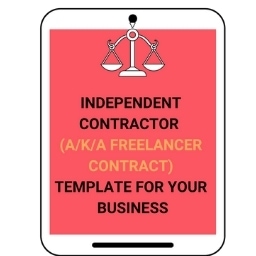In the traditional business world, a handshake was sufficient enough to close a deal, but that is no longer the case.
I’ve heard too many horror stories of bloggers and companies hiring freelancers, only for them to not be the right fit for the company and produce lackluster deliverables.
If you really want to ensure that everything you request of a contractor to complete is performed to certain standards, then you need to use a freelance contract.
The beauty is that once you have a contract, you can make a few adjustments to it to customize a contract for each specific freelancer you work with.
Not sure what goes into a freelance contract?
No worries! That’s what this article is for. I’m going to walk you through 19+ sections of this specific contract that you should include to legally protect yourself and your business.

And, if you’re thinking to yourself…
“I’m not fluent in legal English. I can’t write a competent contract.”
Then, I’ve got a solution for you!
I want you to know that I’ve done it, and you can do it, too. The key is starting out with a robust freelance contract template that covers the legalese so you can focus on customizing the specific elements to fit your current business needs.
Let’s get started!
What is a Freelance Contract?
A freelance contract is a document that you should have your freelancer sign before they begin any work for you. It discusses many things, including, but not limited to:
- Services to be provided
- Effective date
- Compensation
- Ownership of intellectual property
We’ll go over all these elements and more in greater detail later in this article.
Is “Freelance Contract” its Only Name?
Nope!
You may come across templates with different names, including:
- Independent contractor agreement
- Freelancer agreement
- Client/Service freelancer agreement
- Independent consultant agreement
- And more!
All of these are synonymous in nature, but the specific elements might change based on your usage.
Do I Need a Freelance Contract?
Absolutely!
You need a contract to safeguard your business and its financial interests. A signed contract is crucial in the event that you hire the wrong freelancer and need to go to court.
If you don’t have a contract or agreement, then you’re subject to whatever the judge decides. Having an agreement dictates the course of action in the event the freelancer never delivers what was promised or if for some reason, you didn’t compensate the freelancer.
This is an important legal document that helps to go over the:
- Relationship between the parties
- Timeline for completion and deliverables
- Nature of the freelancer’s employment status within the company
- Governing law and dispute resolution
Can’t I Find a Free Freelance Contract to use?
Yes, you can!
But, I can’t promise you that it will cover everything I’ve mentioned above and more. Simply put, they don’t have all of the legal provisions you need to protect your business.
And, even if all the provisions are there, it’s just standard boilerplate text that doesn’t fit your business. When you use them, you’re assuming it’s good to go, but it’s just a rough sketch.
That’s why I’ve teamed up with Amira from A Self Guru to present to you an independent contractor agreement template that walks you through how to customize it to your business.
Now, unlike most lawyers, Amira doesn’t charge an arm and a leg for her freelance contract template.
She believes in empowering small business owners to protect themselves legally and sees you through the entire process. Her customer service is impeccable!
Breaking Down the 19+ Elements of a Proper Freelance Contract
Don’t worry! I’m not going to leave you hanging. I’ll walk through all these sections, but remember that they are ALL included in Amira’s template, so the legalese is covered.
When you construct your agreement, make sure it includes the following sections:
- Background
- Engagement and term
- Services to be provided (or rendered)
- Compensation
- Independent contractor status
- Confidential information
- Ownership of intellectual property
- Termination
- Return of property
- Expenses
- Entire agreement and its modifications
- Successors and assigns
- Severability
- Governing law
- Legal compliance
- Waiver
- Indemnification
- Notices
- Force majeure
- Counterparts and signatures
After reading that, you’ve probably got a headache and I am 100% with you.

Luckily, Amira’s contract template includes standard text for all of these sections and a few more with highlighted text to show you how to customize it to your business.
Let’s break down all of these elements further to give you a brief overview of what they do.
1. Background
This section goes over the following things:
- Effective date
- Contractor’s name
- Client’s name
It’s a general overview of some of the important terms that you will see throughout the entire contract. And, once they are explained, there’s certain verbiage that will replace the full name being repeated again.
Not sure what I mean?
Here’s an example…
Now, whenever “Agreement” is mentioned, you know what it represents. Same thing with “Effective Date.”
This section will typically close with language that expresses that the client and the contractor agree to the sections that follow in the agreement.
2. Engagement and Term
Now that we already established the effective date, it’s time to clarify when the contract will expire and conclude.
That’s what this section goes over. It’s typically no more than a paragraph and states that both parties agree to abide by the terms and conditions of the contract during the set time listed in this section.
Now, the contract does not necessarily have to be finite.
This section is subject to the termination section, which we will discuss later. If your contract doesn’t have an expiration date, then that’s where termination would come in.
3. Services to be Provided
This section describes the scope of the work that you are hiring the freelancer for and its language is pretty much up to you. Rather than phrasing it in legalese, clearly focus on the deliverables.
For example, you might say…
Be sure to include the tasks to be included and the frequency that you expect them to be completed by.
This helps not only you, for protection, but for your freelancer as they have a clear idea as to the deliverables.
4. Compensation
This is my favorite part of the contract!
As a freelancer myself, I love knowing how I’m going to get paid, but it’s very important, as the business owner, to be crystal clear about how you are planning to pay the freelancer.

You should include the specific dollar amount in the contract.
Furthermore, you should explain HOW the freelancer is going to be paid.
Here are some ideas if you’ve never done this before:
- PayPal
- Stripe
- Direct Deposit
- Check
Sometimes, the freelancer might already have an invoicing system that works for them and that they are insistent upon. In that case, clarify that with the freelancer to include the proper verbiage in the freelance contract.
5. Independent Contractor Status
This section can be quite meaty as there are many legal and financial implications of hiring a freelancer versus an employee.
The status referenced includes a few things:
-
- The freelancer counts as an independent contractor and not an employee, which revokes their ability to act upon the company’s behalf or engage in anything as a representative member
- No sums or fees will be held back to cover social security or other tax liabilities
- The responsibility of determining the means and methods to perform the services described in the contract
This is one of those sections where having an independent contractor agreement template really saves you legally.
6. Confidential Information
This is such an important section. As business owners, we have things to protect, whether that be passwords or client names.
A properly worded section of this nature should include:
- Overarching definition of confidential information (as it pertains to the business)
- Nonuse and nondisclosure
- Irreparable harm
You should tailor these sections to fit your business’ needs, but remember that protecting your confidential information is a must and that breaching that can be catastrophic for your business.
7. Ownership of Intellectual Property
Before writing this section, you need to think about who owns the deliverables.
Is it the freelancer or is it you?
You should clearly state who it is and then continue with language that affords rights to that individual regarding its usage.
For example, if you are hiring a ghost freelance writer or someone who doesn’t have a byline next to their articles, you would express that you own the intellectual property (but, you might mention that the freelance writer has permission to use the clip in their portfolio).
Another example might be site design. The website design company might stipulate that language crediting the site design to them with a link back to their site is necessary for use of their services.
However you slice it, you need to brainstorm over the usage of the freelancer to determine the extent of the ownership of intellectual property.
8. Termination
I mentioned in the second section about engagement and terms that termination was related.
This section will go over how to properly terminate the contract if it is ongoing.
For example, you might say…
This section will also discuss the survival of the rights and duties of the client and the contractor toward each other. Basically, when the last payment will be made if it’s terminated and whether the independent contractor status and other former sections endure or not.
9. Return of Property
This section is something that you would probably forget about if you weren’t purchasing a freelance contract template.
Let’s say that you gave the freelancer access to your social media accounts and software subscriptions to properly perform their job. This section would go over the correct method to return that confidential information.
The same goes if there was physical property involved.
Think about all the kinds of property that you might give the freelancer and include them in this section of the contract.
10. Expenses
This section has some flexibility based on how you want to proceed. You can either dictate that…
- You’ll pay for the expenses
- The freelancer will ask for reimbursement for pre-approved expenses
This goes back to thinking about what the freelancer will need to effectively perform their job.
Maybe, there’s a better social media scheduling tool that can help with efficiency. You should have a statement in this section that would dictate how that would get paid for.
11. Entire Agreement and Modifications
This section is typically no more than a paragraph.
It will go over that the agreement in the contract is the entire agreement and that modifications should be done through written consent by both parties.
There’s no need to overcomplicate this section, but it is standard for all kinds of contracts, including the independent contractor agreement.
12. Successors and Assigns
This section goes over how the contractor’s rights and obligations may not be sold, transferred, assigned, pledged, or hypothecated.
It also mentions that the contract is binding not only to the client but to their successors and assigns.
If this makes no sense to you, you’re not alone. Think of this section as dotting your i’s and crossing your t’s. It’s just extra security and it’s a section that comes standard with Amira’s contract template.
13. Severability
In legal terms, severability refers to how the terms of the contract apply if one or more sections are found to be unenforceable or not valid.
Basically, you want to phrase it as the rest of the contract still applying.
It’s important because you wouldn’t want your entire contract to become null and void if one part is unenforceable. That defeats the purpose of the contract.
A severability clause is a staple in any contract.
14. Governing law
If you know where you live, this section will be fairly easy to complete. It goes over what law will govern your contract if there are any disputes that need to be settled.
A complementary clause to governing law is mediation and arbitration.
You probably want to avoid a lawsuit, so pursuing arbitration is a much swifter and cost-efficient method.
The American Arbitration Association can supply arbitrators in your industry if you don’t know one.
15. Legal Compliance
This section is super important in the brick and mortar world, but not as much in the online world.
It states that the freelancer has the certifications, registrations, permits, etc. that it needs to effectively perform the services and provide the deliverables.
But, if you’re hiring a Certified ConvertKit Expert, then it’s expected that individual isn’t misrepresenting their certification.
This section goes over all of that.
16. Waiver
Waiving rights is a big issue in contracts because of its legal implications. This section goes over how a party cannot be waived of its rights unless there is written consent.
It also adds that a waiver of a breach or violation of any provision by either party does not constitute a waiver of a different one.
17. Indemnification
In my experience, the indemnification clause tends to be fought over the most.
Essentially, the clause states that the contractor will hold harmless the client from any damages, losses, liabilities, and expenses as a result of performing the services.
Indemnification clauses can be major issues for small freelancers that don’t have the funds to protect themselves if there is a lawsuit. However, many companies, especially corporate ones, will insist on an indemnification clause.
It’s totally up to you to decide how to word your indemnification clause.
18. Notices
Let’s say a legal issue arose. You need to know how to reach both parties.
This section goes over how notice will be issued.
You should include a sentence that necessitates both parties to inform the other if there is a change in how the notice shall be delivered.
There is nothing quite like an expired home address or an unmonitored inbox when it comes to delivering important communication.
It can also go over what the standard communication is for the duration of the contract.
19. Force Majeure
Say that, again?
If this sounds like the answer to a Jeopardy question you didn’t get right, it probably was.
It’s a legal term that you won’t hear elsewhere. But, it’s an important one, nonetheless.
Basically, it says that if there is an uncontrollable force, neither party will be deemed in default of the obligations of the contract.
Here are some scenarios where force majeure might apply:
- Acts of terrorism
- A devastating hurricane, tornado, flood, or other natural disasters
- Telecommunications failures
- Systematic internet failure
- Act of God
I bolded internet failure because that would be the one you would most frequently run into.
20. Counterparts and Signatures
This section goes over the signing of the contract and how it can be digital or in print.
All of my signatures are digital, but you may prefer a scanned copy of a written signature.
This last section should detail the process to obtain that signature.
Most importantly, get the signature!
That’s what all this work was for. After both parties have signed, it’s time to commence the contract.
A Review of Amira’s Independent Contractor Agreement
Of course, I wouldn’t recommend and stand behind a template that didn’t have all of the sections I just mentioned.
One of the reasons why I love legal contract templates is because of the customizability without having to worry about missing some of the legalese.
If you’re on the fence, here are my thoughts about Amira’s independent contractor agreement.
I recorded a quick video in case you’re on the run and can’t read the entire review.
Check it out!
Pros
In case you haven’t noticed, I really do LOVE Amira’s contracts and legal documents.
Here are a few reasons why…
1. The Contract Covers Everything!
When you search for FREE templates, you usually come across some that look the part, but don’t have everything that you need. With this contract that’s over 9 pages of detailed and protective legalese, you don’t have to worry.
I was one of those people that thought I could manage with a FREE contract.
Boy, was I wrong!
When I thought I had a competent contract (before Amira’s came out), I sent it over to her for review.
She found numerous errors in the legalese, not to mention, I was missing some very important sections. I definitely learned my lesson!
2. It’s Priced VERY Reasonably
Let me be the first to tell you, if you don’t already know already, that lawyers are expensive!
I spent some quality money on a local lawyer to file my LLC; while I don’t regret the $2,000 retainer because of the work that’s involved, I didn’t want to have to pay an arm and a leg for a proper freelance contract.
There are some independent contractor agreements that charge two and three times what she does, without being superior in quality.
Amira’s legal documents are approachable, especially when you’re just hiring a freelancer and don’t have a huge budget.
3. The Contract is Easily Customizable
As a freelancer myself, my time is highly prized. I never have enough of it.
This freelance contract makes it super simple to customize it to your business. After all, you can’t just keep all the boilerplate text as it is. You need to put in a little effort to get it to be tailored to your needs as a client.
But, once you do, it’s simple to do again and again for every freelancer.
Whenever I outsource, having a template makes the process SO much easier.
Plus, the contract you receive comes highlighted, so you know exactly which parts to touch and which to not mess up.
Cons
I don’t have many negatives to report of other than I don’t agree (as a freelancer) with the wording in some of the sections.
Here are a few examples…
1. The Indemnification Section
I believe in wording that’s mutually indemnifying.
What does that mean?
Well, in essence, it means that the contractor and the client will hold each other harmless. The contract is currently written to have the contractor hold the client harmless.
This might sound great if you’re the contractor, but you might not attract freelancers if you set a precedent of passing on damages, fees, and other things of that nature on to the freelancer.
Not to mention, many freelancers, especially writers, like to fight over this clause.
I have mine worded like this (which you can feel free to use):
Except to the extent paid in settlement from any applicable insurance policies, and to the extent permitted by applicable law, each Party agrees to indemnify and hold harmless the other Party, and its respective affiliates, officers, agents, employees, and permitted successors and assigns against any and all claims, losses, damages, liabilities, penalties, punitive damages, expenses, reasonable legal fees, and costs of any kind of amount whatsoever, which result from or arise out of any act or omission of the indemnifying party, its respective affiliate, officers, agents, employees, and permitted successors and assigns that occurs in connection with this Agreement.
This indemnification will survive the termination of this Agreement.
2. Non-Solicitation, Non-Recruit, and Non-Competition Sections
I personally don’t have these sections in my independent contractor agreement, but Amira does include them.
The truth is that depending on your business and it’s nature, it might be necessary.
In that vein, you might also need a non-disclosure, which this contract does not cover and might be an add-on.
I find that these sections are a little too prohibitive for the freelancer since they actively target clients in the same niche quite frequently. I do think there should be clearly established boundaries, though, for the freelancer.
3. No Instructions to Legally Obtain an E-Signature
I’m all about that digital life!
I even had my lawyer book a discovery chat with me through Calendly before I hired him.
I don’t like the hassle of obtaining a physical signature. So, I use a digital signature instead. My clients all read my contract, fill out the WP Forms form at the end, and then I send them a fully executed contract afterward.
That system seems to work very well for me (because of how quickly I can customize the template).
One of my clients uses Docracy to obtain signatures, but I know others use DocHub. If you use one of those, you should be fine.
The key point I’m trying to make is that you need to convey to the signee that they’re filling out a legally binding document. This is the verbiage I use on my own independent contractor agreement (which you can feel free to use).
Of course, these can easily be changed and I’d be happy to work with you after you purchase the contract to customize it for your business.
FAQs Concerning Freelance Contracts
I’d be surprised if you didn’t have any questions!
This is a long, comprehensive article on the topic, which is why I tried to address everything I could think of that might be on your mind.
If your question still isn’t answered, then feel free to post it in the comments below and I will get back to you.
1. Can I use the Same Blanket Contract for Each Freelancer I Hire?
You can use A LOT of the same sections, or what we would call the boilerplate text. That stuff won’t change.
But, you will need to update a few things, including, but not limited to…
- The effective date
- The services to be provided
- The background section
- Expenses
- Compensation
- Ownership of intellectual property
This all depends on the freelancer you hire!
But, having a template (and even further, a template for each kind of freelancer) makes this process much easier.
2. What are Legal Ways to Obtain a Signature Without it Being in Print?
I mentioned this above in my review of Amira’s contract, but here’s a refresher.
There are quite a few companies that act as the document signing 3rd party. Here are a few:
- Hello Sign
- Docracy
- DocuSign
- SignNow
- DocHub
- EverSign
Or, you could provide a form at the end of your contract, if you host it publicly as I do, and then all you would have to do is have them fill out the form. As long as you convey that they’re signing a legally binding document, you’re good!
3. What Should I do if the Freelancer Doesn’t Want to Sign the Contract?
I would explain to the freelancer the importance of a contract to protect the interests of BOTH parties.
Now, if the freelancer has an issue with one of the components of the contract, clarify what the issue is and see if you can adjust it to appease them without compromising your security.
For example, I recently onboarded a client and she mentioned she wanted her email list to be specifically mentioned in my confidentiality section.
That was an easy fix and I was happy to oblige.
You may be facing a steeper revision, but stick with it. Of course, there is an alternative and that is to hire a different freelancer that has no issues with your freelance contract.
But, most freelancers anticipate and want a contract, so this shouldn’t be an issue.
4. What Happens if I Don’t use a Contract?
If you don’t use a contract, you might be subjecting yourself to legal turmoil later down the line. You could get a lawsuit filed against you and have lawyers knocking at your door for payments.
From a client’s perspective, if you don’t clearly establish the capacity of the freelancer, you might end up having to pay social security, Medicare, and other kinds of taxes. You might also get the freelancer performing the wrong tasks if you don’t appropriately elaborate on the services to be provided.
From a contractor’s perspective, you risk not getting paid and being sued for not fully performing the “agreed upon” duties.
All these headaches can be avoided with an independent contractor agreement!
5. How do I Ensure my Intellectual Property is Protected?
This is a big issue for many entrepreneurs I know, including one of the clients that I mentioned above.
You can create specific logins for your freelancers that limit certain functions, depending on the platform.
You can also use language in the contract that enforces strict penalties if any of the information is compromised or used unfairly.
Of course, you should only be hiring freelancers that you trust and don’t think will abuse that relationship.
6. Is There a Freelance Contract you Recommend That’s Easily Customizable?
Yes, absolutely!
I highly recommend Amira’s independent contractor agreement for all the reasons I’ve mentioned above and more.

The highlighted text alone makes the template easy to customize.
If you have any hesitations, don’t feel afraid or embarrassed to ask.
Conclusion
Drafting ANY legal document can be a nightmare if you don’t know what you’re doing.
I found this out the hard way, not only with my freelance contract, but with my terms & conditions, privacy policy, and disclaimer.
What I’ve learned throughout the process is that you really need a lawyer to help you make sure you’re protected.
When I came across Amira, I knew that she was EXACTLY what I needed.
Her freelance contract template is…
- Easily customizable
- Reasonably priced
- Comprehensive in every area
Not to mention, she has excellent customer service skills!
If you find an issue with the template or need help customizing it for your business, Amira is happy to work with you on an individual basis for you to get the most out of her product.
After all, there are 19+ sections to a proper independent contractor agreement.
It’s difficult to wade through all the legalese to come out with a properly formed document.
So, what are you waiting for?
Purchase the freelance contract template today!
Cheers to future success!




